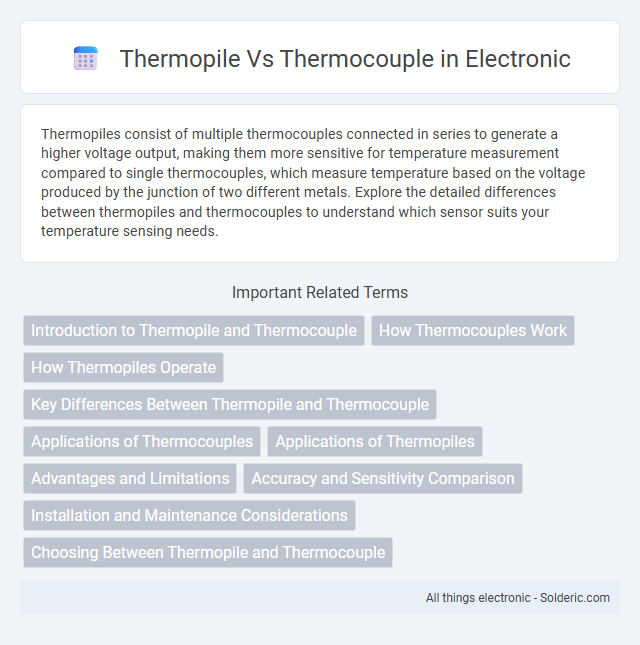Thermopiles consist of multiple thermocouples connected in series to generate a higher voltage output, making them more sensitive for temperature measurement compared to single thermocouples, which measure temperature based on the voltage produced by the junction of two different metals. Explore the detailed differences between thermopiles and thermocouples to understand which sensor suits your temperature sensing needs.
Comparison Table
| Feature | Thermopile | Thermocouple |
|---|---|---|
| Principle | Multiple thermocouples connected in series | Single junction of two different metals |
| Output | Higher voltage output (millivolts to volts) | Low voltage output (microvolts to millivolts) |
| Temperature Range | Wide, typically -40degC to 1000degC | Wide, varies by type (Type K: -200degC to 1350degC) |
| Sensitivity | Higher sensitivity due to multiple junctions | Lower sensitivity, single junction |
| Typical Use | Non-contact temperature measurement, radiation sensing | Contact temperature measurement in industrial processes |
| Construction | Series-connected thermocouples embedded in a single device | Two dissimilar metal wires joined at one junction |
| Response Time | Slower, due to complex structure | Faster response time |
| Cost | Generally higher than thermocouples | Relatively low cost |
| Accuracy | Good accuracy for radiation measurement | Good accuracy for direct temperature measurement |
Introduction to Thermopile and Thermocouple
Thermopiles and thermocouples are sensors that measure temperature using the Seebeck effect, where temperature differences generate voltage. A thermocouple consists of two dissimilar metal wires joined at one end, producing a voltage proportional to temperature difference at the junction. Thermopiles combine multiple thermocouples in series to increase output voltage, enhancing sensitivity and accuracy for precise temperature measurements in various industrial and scientific applications.
How Thermocouples Work
Thermocouples work by generating a voltage through the Seebeck effect when two different metal wires are joined at one end and exposed to a temperature difference. This voltage is directly proportional to the temperature difference between the hot junction and the reference junction, allowing precise temperature measurement. Your application's accuracy depends on choosing the correct thermocouple type based on temperature range and environmental conditions.
How Thermopiles Operate
Thermopiles operate by combining multiple thermocouples connected in series or parallel to generate a higher output voltage from temperature differences. Each thermocouple junction produces a small voltage based on the Seebeck effect, and the aggregated signal in a thermopile enhances sensitivity and accuracy in temperature measurement or heat flux detection. This configuration enables thermopiles to efficiently convert thermal energy into electrical energy for precise temperature sensing in infrared sensors and gas burners.
Key Differences Between Thermopile and Thermocouple
Thermopiles consist of multiple thermocouples connected in series to generate higher voltage output, whereas a single thermocouple produces a smaller voltage corresponding to the temperature difference at its junctions. Thermopiles provide enhanced sensitivity and are commonly used in non-contact temperature measurements and infrared sensing, while thermocouples are widely utilized for direct temperature readings in industrial applications. Your choice between the two depends on the required signal strength, sensitivity, and measurement context.
Applications of Thermocouples
Thermocouples are widely used in industrial temperature measurement due to their wide temperature range and durability, making them ideal for processes such as metal production, power generation, and HVAC systems. Their fast response time and ability to operate in harsh environments allow for precise monitoring in automotive engines, gas turbines, and chemical manufacturing plants. Your industrial applications benefit significantly from thermocouples' reliability and cost-effectiveness compared to thermopiles.
Applications of Thermopiles
Thermopiles are widely used in non-contact temperature measurement applications such as infrared thermometers, gas analyzers, and thermal imaging devices due to their ability to generate higher voltage outputs by combining multiple thermocouples in series. These sensors are ideal for detecting infrared radiation in industrial process monitoring and environmental sensing, where precise, non-invasive temperature readings are essential. Unlike single thermocouples, thermopiles provide enhanced sensitivity and accuracy in applications requiring measurement of radiant heat flux and temperature differences.
Advantages and Limitations
Thermopiles offer higher sensitivity and the ability to measure small temperature differences by combining multiple thermocouples in series, making them ideal for infrared sensors and non-contact temperature measurements. However, they typically have slower response times and larger physical sizes compared to individual thermocouples, limiting their use in fast or compact applications. Thermocouples provide rapid response and high-temperature capabilities, but their output voltage is relatively low and more susceptible to electrical noise, requiring signal amplification for precise measurement.
Accuracy and Sensitivity Comparison
Thermopiles offer higher sensitivity compared to single thermocouples by combining multiple thermocouple junctions in series, resulting in amplified voltage output and improved detection of small temperature changes. Thermocouples provide faster response times but generally exhibit lower accuracy due to their single junction design, making them less effective for precise temperature measurements. Overall, thermopiles excel in applications requiring enhanced accuracy and sensitivity, while thermocouples are preferred for rapid temperature sensing.
Installation and Maintenance Considerations
Thermopiles typically require more complex installation due to multiple thermocouple junctions connected in series, demanding precise alignment for accurate measurements, which can increase maintenance frequency. Thermocouples, with simpler single-junction designs, offer easier installation and lower maintenance needs, making them suitable for applications where quick setup and minimal upkeep are priorities. Your choice between these sensors should consider the trade-off between installation complexity and maintenance requirements based on the specific temperature measurement environment.
Choosing Between Thermopile and Thermocouple
Thermopiles provide higher sensitivity and are ideal for applications requiring precise temperature measurements over a wide range. Thermocouples offer faster response times and durability in harsh environments, making them suitable for industrial temperature monitoring. Your choice depends on whether you prioritize sensitivity or rapid response in your thermal sensing needs.
thermopile vs thermocouple Infographic

 solderic.com
solderic.com